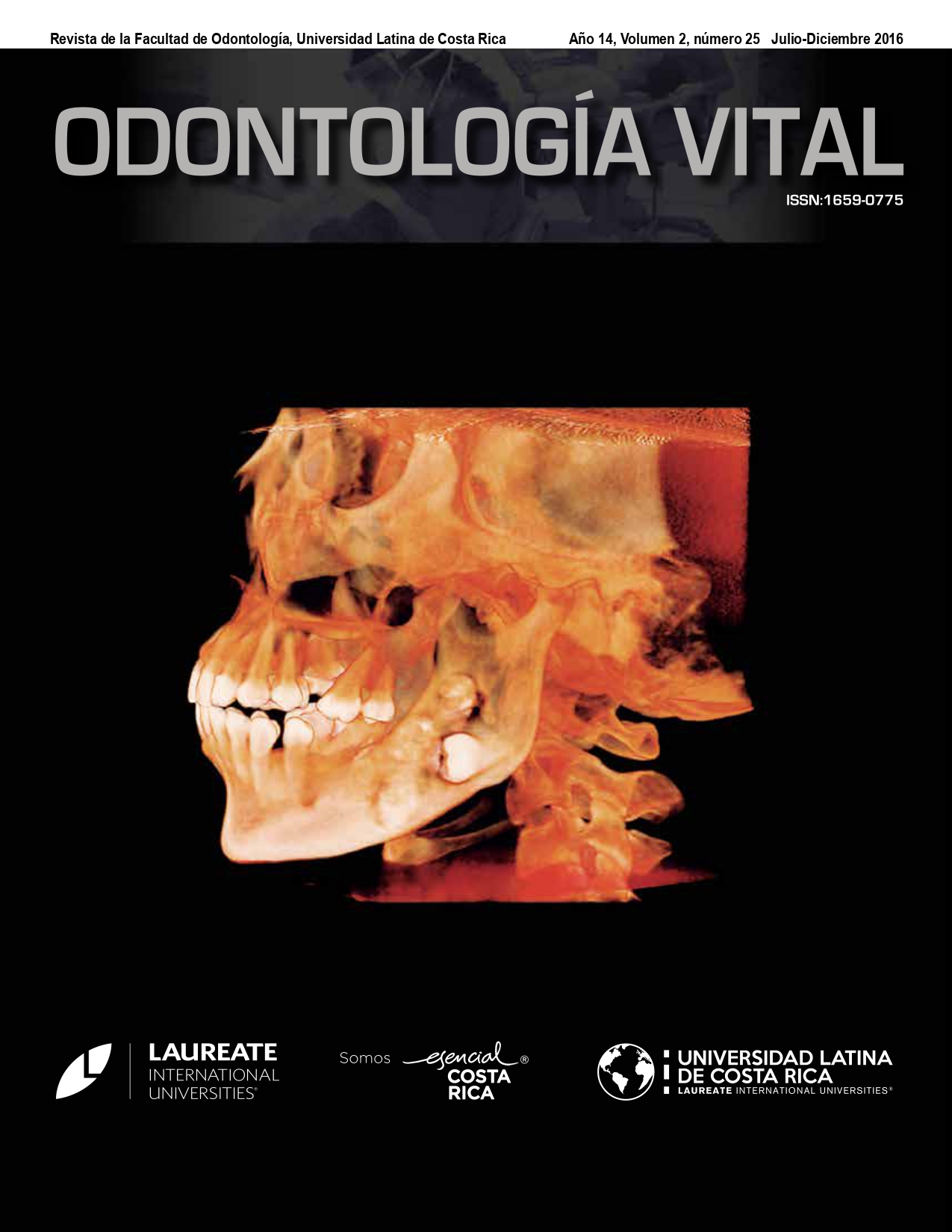Aumento de la temperatura en la superficie dental durante la foto-polimerización
DOI:
https://doi.org/10.59334/ROV.v2i25.240Palabras clave:
Lámpara de fotocurado; LED; halógeno; resinas; irritación térmica.Resumen
Se sabe que durante el fotocurado de los materiales dentales se libera calor, ya sea por parte de la fuente emisora de luz o por la reacción de polimerización del compuesto utilizado. Este aumento de temperatura se transmite a los tejidos, el cual puede repercutir en ellos. Debido a esto, se realiza un estudio comparativo de la temperatura alcanzada durante la obturación y reconstrucción de piezas dentales in vitro, utilizando lámparas de fotocurado de tipo cuarzo-tungsteno halógeno (QTH) , LED y lámparas conformadas por 4 LED, y se analiza sus programaciones: modo rampa, modo intermitente y normal; y se proponen pautas clínicas para reducir los riesgos térmicos potenciales a la pulpa y tejidos de soporte.
Descargas
Referencias
Baldissara, P., Catapano, S., & Scotti, R. (1997). Clinical and histological evaluation of thermal injury thresholds in human teeth: a preliminary study. Journal of Oral Rehabilitation, 791-801. https://doi.org/10.1111/j.1365-2842.1997.tb00278.x
Dogan, A., Hubbezoglu, I., Dogan, O. M., Bolayir, G., & Demir, H. (2009). Temperature Rise Induced By Various Light Curing Units Through Human Dentin. Dental Materials Journal, 253-260. https://doi.org/10.4012/dmj.28.253
Jakubinek, M. B., O’Neill, C., Felix, C., Price, R. B., & White, M. A. (2008). Temperature excursions at the pulp-dentin junction during the curing of light-activated dental restorations. Dental Materials, 1468-1476. https://doi.org/10.1016/j.dental.2008.03.012
Mousavinasab, S. M., & Meyers, I. (2011). Comparison of Depth of Cure, Hardness and Heat Generation of LED and High Intensity QTH Light Sources. European Journal of Dentistry, 299-304. https://doi.org/10.1055/s-0039-1698895
Oberholzer, T. G., Makofane, M. E., du Preez, I. C., & George, R. (2012). Modern High Powered Led Curing Lights and Their Effect on Pulp Chamber Temperature of Bulk and Incrementally Cured Composite Resin. European Journal of Prosthodontics and Restorative Dentistry, 50-55.
Pereira Da Silva, A., Alves Da Cunha, L., Pagani, C., & De Mello Rode, S. (2010). Temperature rise during adhesive and composite polymerization with different light-curing sources.Recuperado el 1 de setiembre de 2014, de Pub-MEd: http://www.ncbi.nlm.nih.gov/pubmed/20502430
Rajesh Ebenezar, A. V., Anilkumar, R., Indira, R., Ramachandran, S., & Srinivasan, M. R. (2010). Comparison of temperature rise in the pulp chamber with different light curing units: An in-vitro study. Journal of Conservative Dentistry, 132-135. https://doi.org/10.4103/0972-0707.71644
Santini, A., Watterson, C., & Miletic, V. (2008). Temperature Rise Within the Pulp Chamber During Composite Resin Polymerisation Using Three Different Light Sources. Open Dental Journal, 137-141. https://doi.org/10.2174/1874210600802010137
Su-Jung, K., Yoon-Jung, P., Sang-Ho, J., Jin-Soo, A., In-Bog, L., Byeong-Hoon, C., Deog-Gyu, S. (2013). Thermal irri-tation of teeth during dental treatment procedures. Restorative Dentistry & Endodontics, 105-112.
Zach, L., & Cohen, G. (1965). Pulp response to externally applied heat. Oral Surgery, Oral Medicine, Oral Patholo-gy, Oral Radiology, and Endodontology|, 515-30. https://doi.org/10.1016/0030-4220(65)90015-0
Descargas
Publicado
Número
Sección
Licencia
Derechos de autor 2016 Douglas Jarquín Hernández, Silvia Bonilla

Esta obra está bajo una licencia internacional Creative Commons Atribución 4.0.
Los autores que publican con Odontologia Vital aceptan los siguientes términos:
- Los autores conservan los derechos de autor sobre la obra y otorgan a la Universidad Latina de Costa Rica el derecho a la primera publicación, con la obra reigstrada bajo la licencia Creative Commons de Atribución/Reconocimiento 4.0 Internacional, que permite a terceros utilizar lo publicado siempre que mencionen la autoría del trabajo y a la primera publicación en esta revista.
- Los autores pueden llegar a acuerdos contractuales adicionales por separado para la distribución no exclusiva de la versión publicada del trabajo de Odontología Vital (por ejemplo, publicarlo en un repositorio institucional o publicarlo en un libro), con un reconocimiento de su publicación inicial en Odontología Vital.
- Se permite y recomienda a los autores/as a compartir su trabajo en línea (por ejemplo: en repositorios institucionales o páginas web personales) antes y durante el proceso de envío del manuscrito, ya que puede conducir a intercambios productivos, a una mayor y más rápida citación del trabajo publicado.








